It Takes A Community
“In North Luangwa National Park, a unique alliance between the Frankfurt Zoological Society, the Department of National Parks & Wildlife, and local Community Resource Boards has led to the flourishing of Africa’s black rhino population. Journeying into the park’s wild heart, we uncover the dedication of the unsung heroes of the community that makes it possible.”
Today, North Luangwa National Park in Zambia is home to one of the fastest-growing black rhino populations in Africa, thanks to the North Luangwa Conservation Programme, a partnership between the Frankfurt Zoological Society (FZS) and Department of National Parks & Wildlife (DNPW) in close cooperation with the surrounding Community Resource Boards (CRB) and traditional leadership.
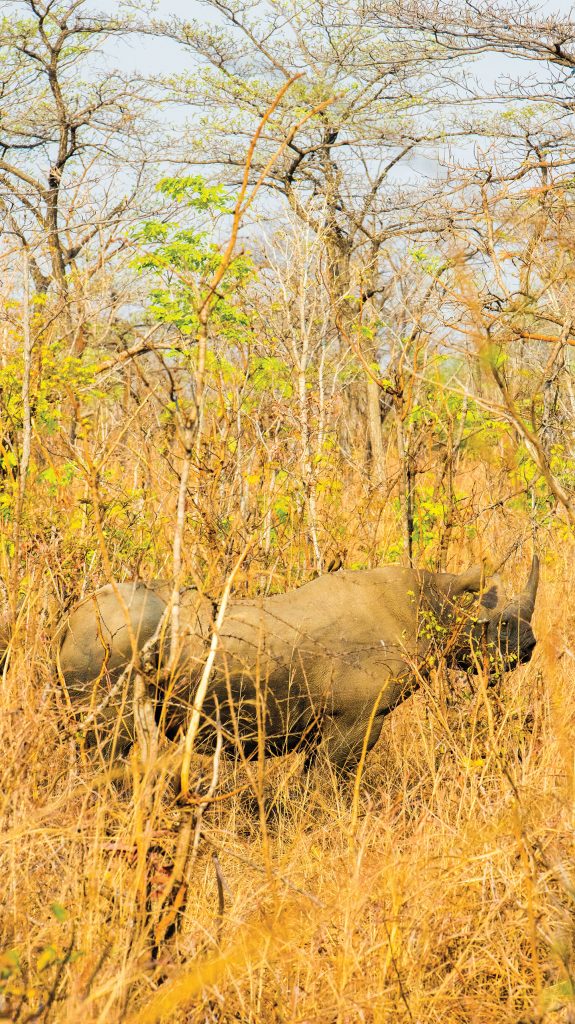
Following their invitation, I embarked on a journey to the rugged and remote wilderness of the park, eager to explore the remarkable efforts of the men and women involved in protecting and preserving one of the world’s most endangered species. My goal was to understand what it takes to ensure the survival of these enigmatic and elusive creatures and share their story.
After a 12-hour drive from Lusaka, my team and I arrived at the FZS headquarters located deep in the heart of the North Luangwa National Park. Rising mountain peaks and deep valley floors characterise the park’s vast expanse of untamed wilderness. It is a land of contrasts where dry savannas meet lush riverbanks carrying life-providing water downstream to the Luangwa River. At HQ, we were greeted by Jacob Mphasi, the Assistant Project Coordinator and other members of FZS and DNPW, who showed us to our tents.
Later that night, seated in one of the supplementary rhino command centres at HQ, we were introduced to the remarkable Paimolo Bwalya, who started as a CRB scout in 2002; he became a Wildlife Police Officer in 2007 and completed several in-service FZS training programs, including exchange programs in neighbouring countries such as Zimbabwe and South Africa. Paimolo’s unwavering dedication and enthusiasm quickly led him to become head of the Rhino Monitoring Unit (RMU). Today, he commands over 150 officers in and around the park.
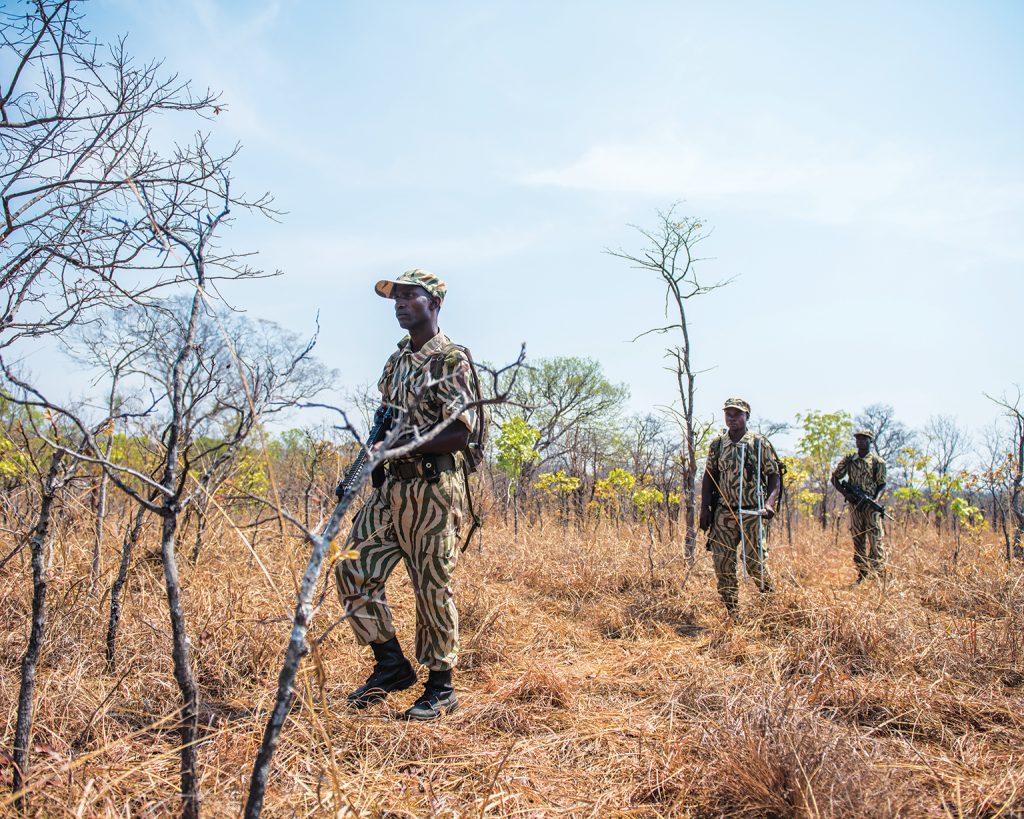
Paimolo’s passion was immediately evident; his composed demeanour and authoritative presence demanded nothing short of your full attention. Seated at the sizeable makeshift meeting table across from us, Paimolo diligently took us through our upcoming itinerary for the next few days and provided us with much-needed insights on the program’s inner workings, ensuring we were well-prepared. He also briefed us about our scheduled rhino-tracking expedition, in which he, along with two other rangers, would guide us on a specially arranged outing designed to offer the team a chance to observe these majestic animals in their natural habitat.
I had never seen a black rhino in the wild, and given the rhino’s shy nature, Paimolo informed us that the odds of seeing one were quite slim. Nevertheless, it was hard to contain my excitement, and having the best rhino tracker in the country leading us gave me hope. As it was the month of October, temperatures often soared to the low 40s. Therefore, hydration backpacks and salts were crucial to our arsenal as we were expected to hike around seven to ten kilometres in pursuit of Ichuma, a dominant but allegedly mild-mannered rhino bull.
The following morning, after a fifteen-kilometre drive through the park’s winding dusty trails, we arrived at our location to commence our on-foot pursuit of Ichuma. Paimolo and his team climbed atop their vehicle, where they spent several minutes on their radio telemetry units searching for a faint signal that would point us in the right direction. Ichuma was explicitly singled out for this outing due to his relaxed disposition. Black rhinos, in general, tend to be rather timid and may react aggressively, including charging, when they feel alarmed or startled.

Moments later, Paimolo descended off his vehicle, looked at us with his piercing gaze and uttered, “I got them. They’re 750 metres away. Now, pay close attention. Walk in a single file behind me, do not stick out your head to get a better look, be mindful not to step on twigs, keep your voices hushed, ensure your camera shutters are set to silent, and, most importantly, remember not to run if they charge. Instead, find a tree to climb if you can’t lie down. Their eyesight is quite poor.” Upon hearing that, my team and I exchanged panicked glances; I couldn’t help but envision tomorrow’s headline: “Nkwazi Field Team Trampled by Half-Blind Rhino”. What a comical end to a career spent exploring the most remote parts of Zambia.
Shaking off that fanciful notion, we proceeded on foot, mirroring Paimolo’s every step and often changing our approach direction to counter the wind. Rhinos have a superb sense of smell, a necessary compensation for their relatively poor eyesight. About ten minutes later, Paimolo whispered and pointed at the thick bush ahead, “Shhh, they are over there; get down and follow me.” We stealthily navigated the dense brush and took cover behind a giant anthill. Before us, Ichuma and two of his lovely ladies browsed in the soft morning light. We fell silent, awestruck by their majesty, often crouching to avoid their attention. As the camera shutters silently fired away, I remember feeling like a paparazzi stalking a celebrity out on a morning coffee run; it felt almost voyeuristic.

Unable to contain our enthusiasm, we violated one of Paimolo’s cardinal rules by extending our heads a bit too far, startling Ichuma in the process of capturing photos. With Ichuma startled and panicked, we scanned the vicinity for trees to climb, only to find that the sparse tree cover wasn’t nearly enough to support adult males. Opting to lie down behind the anthill, we took our chances. Ichuma faked a charge before leading his harem away. We took a few minutes to collect ourselves and decided to, bravely or stupidly, continue trailing them for clearer images over a few more kilometres, but our efforts were in vain. With temperatures fast approaching the high 30s, we called it quits and retraced our steps back to our vehicle.
Back at HQ, as we approached the workshop, I gained a more comprehensive perspective and understanding of the scale of this operation. Mechanics and electricians were hard at work repairing the fleet of vehicles, bikes, and buggies parked outside their workshop —undoubtedly being serviced due to the substantial distance they covered each month. In camp, we had the opportunity to meet logistics managers, community representatives and other DNPW staff. I was observing an entire hive of individuals working and collaborating together in a reasonably inhospitable and remote environment, exemplifying NLCP’s mission of linking livelihoods and landscape. This collective effort underscored a shared commitment and purpose among the team members.
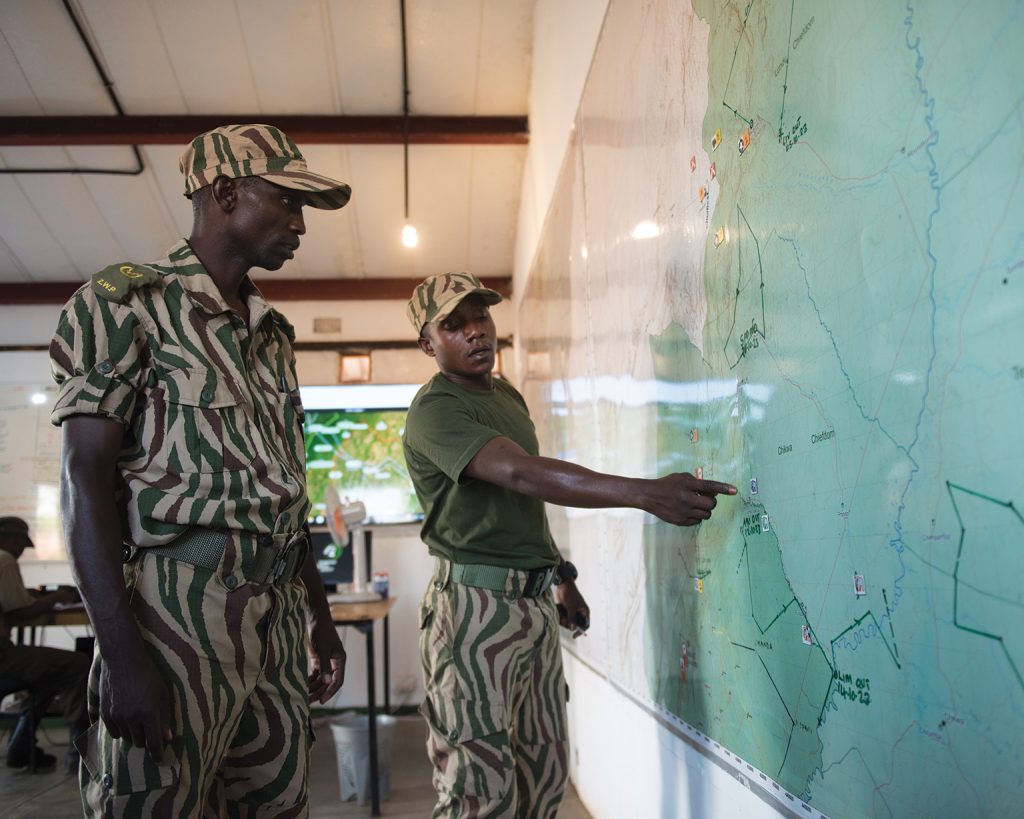
Later that afternoon, we visited the Rhino and Elephant Protection Unit (REPU) command centre positioned a few kilometres from HQ perched atop a hill. We reunited with Paimolo and his team, who graciously guided us through the facility. The site featured a one-kilometre-long airstrip used by the aerial surveillance team and logistics providers. Additionally, the facility boasted a rhino enclosure used to temporarily hold, rehabilitate and care for rescued rhinos, often brought in following air recovery missions. Paimolo recounted an incident where a rhino wandered to South Luangwa National Park and was later recovered and transported back by helicopter.
We were also given a tour of the canine facility, where highly skilled female handlers demonstrated the unique abilities of their extensively trained dogs; the NLCU has five dogs trained to detect and track ammunition, guns, elephant ivory, rhino horn, and bushmeat.
Paimolo also gave us an exclusive glimpse of their central command centre, a scene right out of a James Bond movie. The command centre serves as an intelligence hub, receiving reports from various law enforcement units operating within the park and across the five chiefdoms surrounding it. Multiple rangers staffed it and used state-of-the-art surveillance technology to monitor animal movements.

Paimolo’s dedication, affinity, and admiration for his team were more apparent at the command centre. I couldn’t help but notice the effortless respect in the room, akin to the relationship between an esteemed chief and his loyal subjects. It was a testament to the strong bond formed over the many years of dedication to the mission.
In contrast to our previous unconventional outing with Paimolo, we were scheduled to accompany a female ranger team on a routine tracking patrol the following morning. We picked up the unit from one of the many picket posts strategically located within the rhino sanctuary. These posts serve as overnight resting areas for the tracking units.
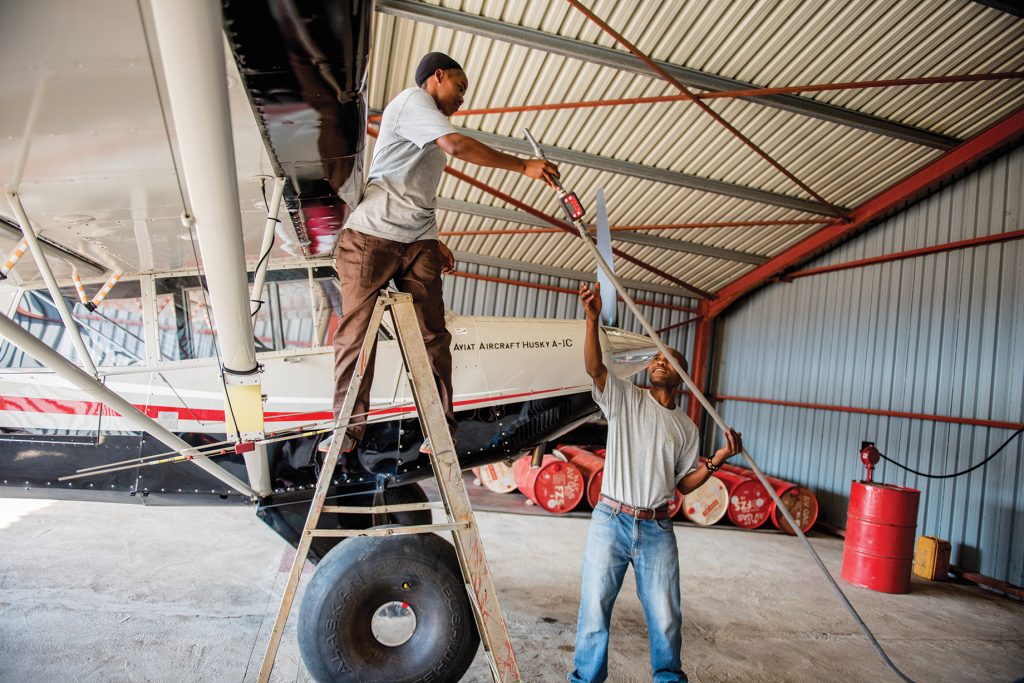
Under the sweltering 40-degree heat, we embarked on our five-hour journey, following the highly skilled female rangers. As the relentless sun beat down and the fatigue set in, we couldn’t help but appreciate the team’s unwavering commitment. I began to understand that their motivation wasn’t rooted in job security but in a deep passion for their work and mission. This powerful drive enabled them to overcome physical discomfort and the harshest of nature’s elements. Regardless of the weather, be it the scorching summer, chilly winter or the rainy season, these teams cover 12 kilometres of rugged, unforgiving terrain daily.
Back at camp, the team and I had one thing left on our itinerary: a community visit to Chifunda; however, the visit was cancelled due to a death at the village; not wanting to disrespect local traditions, we voted against proceeding with it. Instead, we spoke with Bester Muzeya, one of the leading Community Conservation Officers, who explained how much of a positive impact the program has had, especially on incidences of human-animal conflict.
Now, instead of live rounds, villagers employed chilli bombs blasted from improvised PVC guns to deter animals from consuming their crops—a simple solution to an otherwise serious problem.
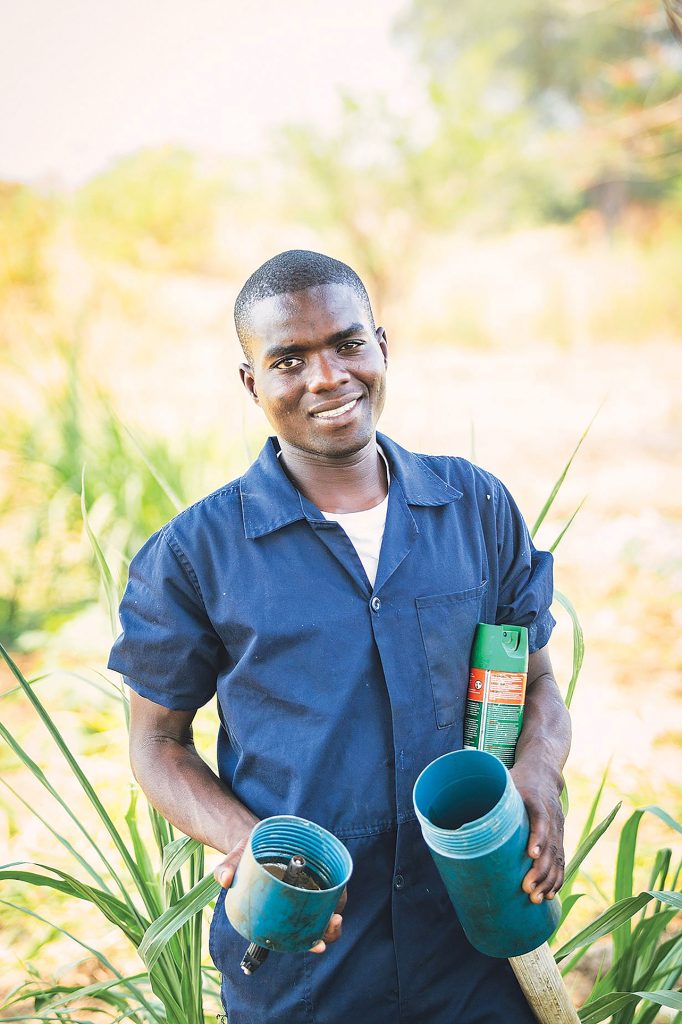
As the famous African saying goes, “It takes a village to raise a child,” this principle has proved that it extends far beyond human lives. In this remote African wilderness, it truly takes a community to safeguard the existence of a magnificent but vulnerable species. The black rhino’s survival, once teetering on the brink of extinction due to poaching and habitat loss, is now a testament to the unwavering dedication of those involved in the North Luangwa Conservation Programme.
The behind-the-scenes operations we witnessed at the HQ, the REPU command centre, and the canine facility, all supported by an intricate network of dedicated individuals, showcased the complexity and scale of this conservation effort. These unsung heroes, many being women, play a vital role in protecting rhinos and other wildlife from poaching and encroachment.
In the end, the story of North Luangwa National Park is one of hope, resilience, and the power of a united community. It serves as a reminder that we all have a role to play in protecting our planet’s biodiversity and that with dedication, passion, and cooperation, we can ensure the survival of even the most endangered species. This journey reinforced the idea that conservation is a collective responsibility that we should all embrace to secure a better future for our planet and its precious inhabitants.

Did You Know?
- The black rhino was once abundant in Africa, numbering around 70,000 strong. They dwindled to a mere 2500 in the mid-1990s due to habitat loss, poaching, and other threats.
- As of 2023, 6487 rhinos remain in the wild, a testament to the effectiveness of conservation.
- In 1998, Zambia declared the elusive and enigmatic black rhino (Diceros Bicornis) officially extinct, but three decades earlier, it was home to the third-largest black rhino population globally.
- The rhino population has witnessed a three-fold increase since their initial reintroduction in North Luangwa National Park. Even more heartening is that 80% of the current rhino population was born in the park.
Fast Facts:
● 0 Incidences of rhino poaching since the reintroduction in 2003.
● 413 Law Enforcement Officers supported.
● 6,000 Elephants in NLNP – the highest density of elephants in Zambia.
● 120 Km Covered per shift by a Rhino Tracking Unit.
● 100 Vehicles used.
● 2,100 Km Covered by foot per rhino ranger annually.
● 5% Compound growth rate of rhino population.
● 169 Firearms confiscated.
● 13 Ivory seizures.
● 70,000 Rural households engaged.
● 55 Chilli Blast teams.
● 1,800 Students in conservation clubs.
● 30,000 Km covered by vehicle per year.
● 1,300 Km of roads maintained.



